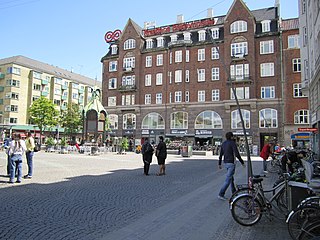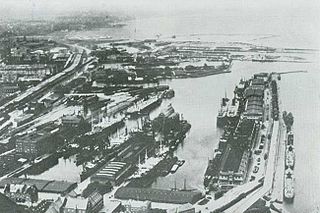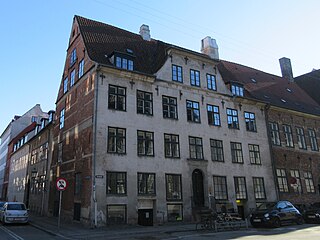
Christian's Church is a Rococo church in the Christianshavn district of Copenhagen, Denmark. Designed by Nicolai Eigtved, it was built 1754–59.
Philip de Lange was a leading Dutch-Danish architect who designed many different types of building in various styles including Dutch Baroque and Rococo.

Sankt Annæ Plads is a public square which marks the border between the Nyhavn area and Frederiksstaden neighborhoods of central Copenhagen, Denmark. It is a long narrow rectangle which extends inland from the waterfront, at a point just north of the Royal Danish Playhouse at the base of the Kvæsthus Pier, now known as Ofelia Plads, until it meets Bredgade. A major renovation of the square was completed in 2016.The Garrison Church is located on the south side of the square. Amaliegade, one of the two axes on which Frederiksstaden is centered, extends from the square.

Wilders Plads is a waterfront area located just north of Wilders Kanal, a branch of Christianshavns Kanal, in the north-western corner of the Christianshavn neighbourhood of Copenhagen, Denmark. The area is bounded by Christianshavn Canal to the east and Krøyers Plads to the north.

Larsens Plads is a waterfront in Copenhagen, Denmark, which runs along the Zealand side of the Inner Harbour from the Nyhavn canal in the south to the Nordre Toldbod area just south of Langelinie to the north. The name refers to a shipyard which used to occupy the grounds but is now more associated with emigration to America after it became a major hub for trans-Atlantic traffic later in the century. It is dominated by Amalienborg Palace with the Amalie Garden and a number of late 18th-century warehouses which have been converted to other uses. The buildings facing the waterfront have their address on the parallel street Toldbodgade.

The Old Artillery Barracks, also known as Irgens House after an earlier owner, was the first of three barracks to be established in the Christianshavn district of Copenhagen, Denmark. The complex has been converted into apartments and is listed.

Christianshavns Torv is the central public square of the Christianshavn neighborhood in Copenhagen, Denmark. It is situated at the intersection of Torvegade and Christianshavn Canal, roughly at the center of the area.

Jacob Holm was a Danish industrialist, ship owner and merchant. He founded the company Jacob Holm & Sønner, which still exists today.

Applebyes Plads is a triangular area located between Langebro Bridge and the southernmost portion of Christianshavn Canal at the southern tip of the Christianshavn neighbourhood in Copenhagen, Denmark. The area takes its name from Peter Applebye, Christian VI's rope maker, who ran his manufactury from the site in the late 18th century, although no buildings remain from that time. The Danish Sugar Factories' building along the waterfront dates from 1912 while the rest of the grounds have undergone residential redevelopment in later years.

The Free Port of Copenhagen is a bonded area in the northern part of Port of Copenhagen of Copenhagen, Denmark. Created to consolidate Copenhagen's position as an important maritime hub in Northern Europe, it was established in the area just north of the fortress Kastellet and later expanded northwards several times. The original grounds, now known as Søndre Frihavn, has since been released for other uses. It comprises Amerika Plads, a modern mixed-use development, America Quay, India Quay, Langelinie and Marble Pier, the four quays which bounded the harbour, and Midtermolen, a pier which divides it into an east and west basin.

The Prince Wilhelm Mansion is a historic property on the corner of Sankt Annæ Plads and Amaliegade in central Copenhagen, Denmark. It is owned by the property investment company Jeudan which is headquartered in the building.

Sankt Annæ Gade is a street in the Christianshavn district of Copenhagen, Denmark. It connects the main harbourfront at Asiatisk Plads in the west to Christianshavn Rampart in the east via the Snorrebroen bridge. Church of Our Saviour is located in the street.
Johan Christian Conradi was a German born, Danish master builder, contractor and architect.

Strandgade is one of the principal streets in the Christianshavn district of Copenhagen, Denmark. It runs along the full length of the neighbourhood, following the waterfront of the Inner Harbour, from Christian's Church in the south-west to Grønlandske Handels Plads in the north.

Andreas Bjørn was a Danish merchant, shipbuilder and ship owner.

(Kongelige) Grønlandske Handels Plads is a waterfront area at the end of Strandgade in the northwestern corner of the Christianshavn neighbourhood of Copenhagen, Denmark. The area is bounded by the Trangraven canal to the north, Christianshavn Canal to the east, Krøyers Plads to the south and the main harbor to the west. The waterfront is also known as Nordatlantens Brygge. It is named for the Royal Greenland Trading Department and was for more than 200 years a hub for Danish trade on Greenland, Iceland and the Faroe Islands. The most notable building is North Atlantic House, an 18th-century warehouse now used as a cultural centre for the North Atlantic area.

The Mikkel Vibe House is a historic property located at Strandgade 32 in the Christianshavn neighbourhood of Copenhagen, Denmark. It is believed to be the oldest building in Christianshavn and takes its name after Mikkel Vibe who was mayor of Copenhagen.

The Jacob Holm House is a historic property located at Strandgade 4B in the Christianshavn neighbourhood of Copenhagen, Denmark. It was owned by the wealthy industrialist and shipowner Jacob Holm from 1819 to 1845.
Johan Bernhardt Schottmann was a German-Danish master builder who worked in Copenhagen, where he was an early proponent of the Neoclassical style. The Schottmann House at Strandgade 10 in Christianshavn is named after him.

Danish Asiatic Company was a Danish trading company established in 1730 to revive Danish trade on the Danish East Indies and China following the closure of the Danish East India Company. It was granted a 40-year monopoly on Danish trade on Asia in 1732 and taken over by the Danish government in 1772. It was headquartered at Asiatisk Plads in Copenhagen. Its former premises are now used by the Ministry of Foreign Affairs.




















